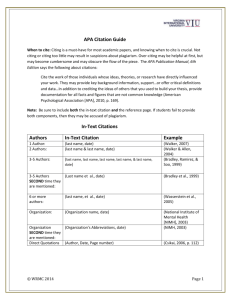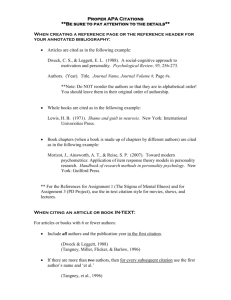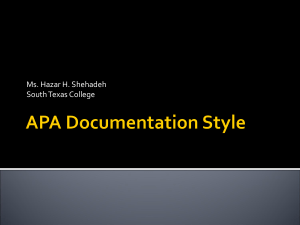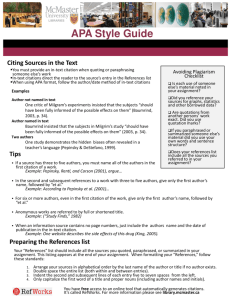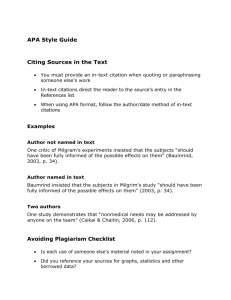Gabriele Library, Immaculata University APA STYLE
advertisement
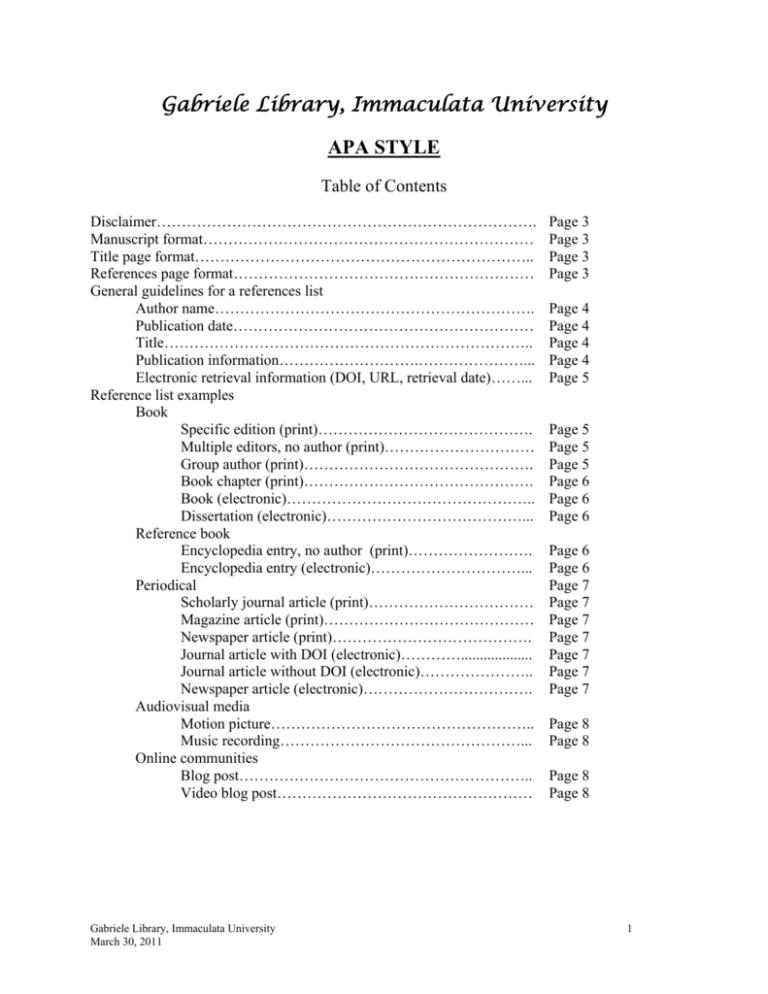
Gabriele Library, Immaculata University APA STYLE Table of Contents Disclaimer…………………………………………………………………. Manuscript format………………………………………………………… Title page format………………………………………………………….. References page format…………………………………………………… General guidelines for a references list Author name………………………………………………………. Publication date…………………………………………………… Title……………………………………………………………….. Publication information……………………….…………………... Electronic retrieval information (DOI, URL, retrieval date)……... Reference list examples Book Specific edition (print)……………………………………. Multiple editors, no author (print)………………………… Group author (print)………………………………………. Book chapter (print)………………………………………. Book (electronic)………………………………………….. Dissertation (electronic)…………………………………... Reference book Encyclopedia entry, no author (print)……………………. Encyclopedia entry (electronic)…………………………... Periodical Scholarly journal article (print)…………………………… Magazine article (print)…………………………………… Newspaper article (print)…………………………………. Journal article with DOI (electronic)…………................... Journal article without DOI (electronic)………………….. Newspaper article (electronic)……………………………. Audiovisual media Motion picture…………………………………………….. Music recording…………………………………………... Online communities Blog post………………………………………………….. Video blog post…………………………………………… Gabriele Library, Immaculata University March 30, 2011 Page 3 Page 3 Page 3 Page 3 Page 4 Page 4 Page 4 Page 4 Page 5 Page 5 Page 5 Page 5 Page 6 Page 6 Page 6 Page 6 Page 6 Page 7 Page 7 Page 7 Page 7 Page 7 Page 7 Page 7 Page 8 Page 8 Page 8 Page 8 1 Reference list examples (continued) Other Work with 8 or more authors (print)…………………….... Book review (electronic)………………………………….. Government report (electronic)…………………………… Non-government report (electronic)……………………… Website…………………………………………………… In-text citations General guidelines………………………………………………… Author variations………………………………………………….. Citing part of a source…………………………………………….. Examples Work with author…………………………………………. Citing an exact quotation…………………………. Work with group author…………………………………... Work with no author……………………………………… Work with no page numbers……………………………… Work discussed in a secondary source……………………. References………………………………………………………………… Gabriele Library, Immaculata University March 30, 2011 Page 8 Page 9 Page 9 Page 9 Page 9 Page 9 Page 10 Page 10 Page 10 Page 11 Page 11 Page 11 Page 12 Page 12 Page 13 2 Disclaimer The information in this document is based on guidelines put forth in the Publication Manual of the American Psychological Association (6th ed.). It is not all-inclusive. The examples provided are not approved by the American Psychological Association. For official APA citation examples, or for help with complex research manuscripts and more in-depth information, please consult the Publication Manual of the American Psychological Association. MANUSCRIPT FORMAT Numbers in parentheses denote sections in the Publication Manual of the American Psychological Association (6th ed.). See figures 2.1 and 2.2 in the Publication Manual of the American Psychological Association (6th ed.) for visual examples of manuscript format. General manuscript format • • • • • • • • Use 12-point Times New Roman (8.03). Double-space all parts of the manuscript (8.03). Use 1 inch margins on the top, bottom, right, and left of every page (8.03). Use a running head, i.e. an abbreviated title, to identify each page. Place the running head at the top left of every page in all capital letters (8.03). On page 1 only, precede the running head with “Running head:” (Figure 2.1). Number each page, starting with the title page, in the top right corner next to the running head (8.03). Space once after punctuation at the end of a sentence (4.01) Indent the first line of each paragraph ½ inch (8.03). Indent each line of a long quotation (40 words or more) ½ in. with no quotation marks. Short quotations (less than 40 words) are included within the text and are enclosed in quotation marks (6.03). Title page format • • • • Center the title between the right and left margins in the upper half of the page (2.01). Center the author name(s) double-spaced below the title (2.02). Center the institutional affiliation double-spaced below the author name(s) (2.02). If required, include an author note under the centered heading Author Note below institutional affiliation (not typically required for theses and dissertations) (2.03). References page format • • • • Center the title References on a new page (2.11). Double-space down to your first entry, and double-space the entire references list including the entries themselves (2.11) (examples that follow are single-spaced to save space). The first line of a reference should start at the left margin. Indent the second and subsequent lines of a multi-line reference (2.11). Alphabetize entries by author or by title if there is no author (6.25). Gabriele Library, Immaculata University March 30, 2011 3 GENERAL GUIDELINES FOR A REFERENCES LIST **Not all pieces of information will be available for all sources** For both PRINT and ELECTRONIC sources, include 1) through 4) below For ELECTRONIC sources, also include 5) 1) Author name(s) (6.27) Invert all authors’ names. Use initials for the author’s first and middle names. For up to 7 authors, list them all. Separate the authors with a comma, and use an ampersand (&) before the last author listed. If there are 8 or more authors, list the first 6 authors followed by a comma, 3 ellipses, and then the last author’s name. If a book is edited and there is no author named, type the editor’s name where the author normally goes followed by (Ed.). If a book is edited and an author is named (as in the case of a book chapter), include the editor’s name between the word In and the title of the entire work. Follow the name with (Ed.) as above and a comma before the title. Do not invert the editor’s name in this case since it is not in the author position. If there is no author or editor, start with the title. 2) Publication date (6.28) If there is no date, type (n.d.) in its place. Use the year only except in the case of magazines, newsletters, and newspaper articles in which case include the year, month, and day (or year and season) if available. Separate the year from other date elements with a comma, and enclose the entire date in parentheses. 3) Title(s) (6.29) You may have more than one title depending on whether you are referencing an entire work (e.g. a book, in which case you will include the title of the book only) or you are referencing an entry within a work (e.g. a chapter within a book, in which case you will include both the title of the chapter and the title of the book). Italicize the title of an entire work (e.g. a book or journal name) but not an entry within that work (e.g. a chapter in a book or an article within a journal). For entire books, book chapters, articles, entries within a larger work, and other non-periodicals, only capitalize the first word of the title and subtitle as well as proper names. For periodical names, capitalize all important words. 4) Publication information (6.30, 7.02) For periodicals, include the volume number (italicized) followed by the issue number (not italicized), if applicable, in parentheses. Then give the article’s page number(s). Do not precede page numbers with p. or pp. except for newspaper articles. For books, include the city and 2-letter state abbreviation, followed by a colon. Then give the name of the publisher, omitting unnecessary words. Include specific editions (nth ed.), volumes (Vol. n), or page numbers (pp. n-n) in parentheses after the title. Include nonroutine information (such as brochure or CD) in brackets after the title. Gabriele Library, Immaculata University March 30, 2011 4 For ELECTRONIC sources only, also include the following: 5) Electronic retrieval information (6.32, 7.01 no. 9, 7.05) a. DOI -OR- URL 1. If available, include the DOI (Digital Object Identifier) only. It is often found on the first page of a journal article. Do not use an ending period for references ending in a DOI. To locate a work using the DOI, use the DOI resolver at http://dx.doi.org/ or http://www.crossref.org/. 2. If a DOI is not available, include the home page URL of the work. For works available by subscription only, you may need to use a search engine to identify the home page URL. For example, if the work is in the subscription journal Lancet, you could use Google to identify Lancet’s home page as http://www.thelancet.com/. The exact URL can be used for open-access works if the work is difficult to locate from the home page. For hard-to-find archival documents that can only be found using a database, use the home page URL of the database or the subscription database name. Do not use an ending period for references ending in a URL. b. Do not include a retrieval date unless the work is likely to be changed or updated. __________________________________________________________________________ REFERENCE LIST EXAMPLES Examples are specific to print and electronic sources as indicated in parentheses. Whenever necessary, modify for print or electronic sources as detailed above. Book Basic format for print books: Author’s last name, initials. (Year). Book title. Location: Publisher. Basic format for electronic books: Author’s last name, initials. (Year). Book title. Retrieved from URL 1) Specific edition (print): Badke, W. B. (2004). Research strategies: Finding your way through the information fog (2nd ed.). New York, NY: IUniverse. 2) Multiple editors, no author (print): Brown, J., Goodman, K. S., & Marek, A. M. (Eds.). (1996). Studies in miscue analysis: An annotated bibliography. Newark, DE: International Reading Association. 3) Group author (print): Renal Dietitians Dietetic Practice Group of the American Dietetic Association. (1993). National renal diet : Professional guide. Chicago, IL: American Dietetic Association. Gabriele Library, Immaculata University March 30, 2011 5 4) Book chapter (print): Tannenbaum, A.J. (1997). The meaning and making of giftedness. In N. Colangelo & G.A. Davis (Eds.), Handbook of gifted education (2nd ed., pp. 27-42). Boston, MA: Allyn and Bacon. 5) Book (electronic): Mackay, J. & Eriksen, M. P. (2002). The tobacco atlas. Retrieved from http://www.who.int/tobacco/resources/publications/tobacco_atlas/en/ 6) Dissertation (electronic): Dissertations are typically hard-to-find works; include database name and accession number if available. Nepps, M. T. (2007). Assessment data: An analysis of the impact on informed reading instruction (Doctoral dissertation). Retrieved from ProQuest Dissertations & Theses @ Immaculata University database. (AAT 3255776) Reference book Basic format for print reference books: Author’s last name, initials. (Year). Entry title. In editor’s name (Ed.), Reference book title (page nos.). Location: Publisher. Basic format for electronic reference books: Author’s last name, initials. (Year). Entry title. In editor’s name (Ed.), Reference book title. Retrieved from URL If there is no author, start with the title of the entry. 7) Encyclopedia entry, no author (print): Bolivia. (1998). In The New Encyclopaedia Britannica (15th ed., Vol. 15, pp. 157-168). Chicago, IL: Encyclopaedia Britannica. 8) Encyclopedia entry (electronic): Alberti, G., & Tattersall, R. B. (2001). Diabetes mellitus. In S. Lock (Ed.), The Oxford companion to medicine. Retrieved from http://www.oxfordreference.com Gabriele Library, Immaculata University March 30, 2011 6 Periodical Basic format for print periodicals: Author’s last name, initials. (Date). Article title. Periodical Title, Volume(Issue), page nos. Basic format for electronic periodicals: Author’s last name, initials. (Date). Article title. Periodical Title, Volume(Issue), page nos. DOI -ORAuthor’s last name, initials. (Date). Article title. Periodical Title, Volume(Issue), page nos. Retrieved from URL • Include year only for journal articles. • Only include issue number if each issue in a volume starts on page 1. • For newspaper articles, include p. or pp. before page numbers. 9) Scholarly journal article (print): Rong, X.L. & Preissle, J. (1997). The continuing decline in Asian American teachers. American Educational Research Journal, 34, 267-293. 10) Magazine article (print): Dokoupil, T. (2007, October 22). Polarizing bears no more. Newsweek, 150(17), 16. 11) Newspaper article (print): Henry, C. (2009, May 19). N.J. bill would require coverage for autism. The Philadelphia Inquirer, pp. A1, A4. 12) Journal article with DOI (electronic): Wanko, N.S., Brazier, C.W., Young-Rogers, D., Dunbar, V.G., Boyd, B., George, C.D.,…Cook, C.G. (2004). Exercise preferences and barriers in urban African Americans with type 2 diabetes. The Diabetes Educator, 30(3), 502-513. doi: 10.1177/014572170403000322 13) Journal article without DOI (electronic): Chuang, Y. (2005). Neighborhood watch: Power, conflict and urban local politics. Taiwan Journal of Anthropology, 3(2), 79-114. Retrieved from http://www.asiastudies.com/2tja.html 14) Newspaper article (electronic): Krauss, C. (2007, October 18). Seeing sugar’s future in fuel. The New York Times. Retrieved from http://www.nytimes.com ____________________________________________________________________________ Gabriele Library, Immaculata University March 30, 2011 7 Audiovisual Media 15) Motion picture Basic format: Producer’s last name, initials (Producer), & Director’s last name, initials (Director). (Year). Title of motion picture [Motion picture]. Country: Studio. Brown, Y. (Producer), & Tullos, J.M. (Director). (2006). Consulting with teachers [DVD]. Washington, DC: American Psychological Association. 16) Music recording Basic format: Writer’s last name, initials. (Copyright year). Song title [Recorded by artist name if different than writer]. On Album title [Medium] Location: Label (recording year if different than copyright year) Springstein, B. (1990). My hometown. On Born in the U.S.A. [CD] New York, NY: Sony. ____________________________________________________________________________ Online communities Basic format for online communications such as newsgroups, online forums or discussion groups, electronic mailing lists, blogs, and video blogs: Author’s last name, initials. (Year, Month Day). Post title [Description of form]. Retrieved from URL 17) Blog post Inniss, J.P. (2009, September 7). When is silence golden? [Web log post]. Retrieved from http://nortonbooks.typepad.com/everydaysociology/ 18) Video blog post (e.g.YouTube) Grantwebb13. (2007, September 9). World War I memorial [Video file]. Retrieved from http://www.youtube.com/watch?v=wHvfI8FcFYo ____________________________________________________________________________ Other 19) Work with 8 or more authors (print): George, S.Z., Teyhen, D.S., Wu, S.S., Wright, A.C., Dugan, J.L., Guijun, Y.,…Childs, J.D. (2009). Psychosocial education improves low back pain beliefs: Results from a cluster randomized clinical trial (NCT00373009) in a primary prevention setting. European Spine Journal, 18(7), 1050-1058. Gabriele Library, Immaculata University March 30, 2011 8 20) Book review (electronic): Rogers, M. (2003). Lord of the flies (book) [Review of the book Lord of the Flies, by W. Golding]. Library Journal, 128(19), 103. Retrieved from http://www.libraryjournal.com/ 21) Government report (electronic): National Institutes of Health, Office of Dietary Supplements. (2005, September 23). Dietary supplement fact sheet: Calcium. Retrieved from http://ods.od.nih.gov/factsheets/calcium.asp 22) Non-Government report (electronic): Spalter-Roth, R. & Scelza, J. (2009, June). What’s happening in your department with assessment? Retrieved from American Sociological Association, Research and Development Department website: http://www.asanet.org/galleries/defaultfile/ASAdeptsvybrief3.pdf Include the publisher as part of the retrieval element if the publisher does not already appear as the author. 23) Website Philadelphia Museum of Art. (n.d.). Visitor information. Retrieved September 11, 2009, from http://www.philamuseum.org/visit/12-270.html GENERAL GUIDELINES FOR IN-TEXT CITATIONS Within the text of your paper itself, you need to tell your readers where you’ve gotten your information by referring them to a source in your references list. To do this, you will use a parenthetical or in-text citation. Every in-text citation should correspond to an entry in the references list with two exceptions--classical works, such as the Bible, and personal communications, such as a personal interview. These require in-text citations but do not appear in the references list. Basic format: (author’s last name, year of publication) where author is one of the authors in your references list. If there are multiple authors, precede the last author’s name with an ampersand (&). If the author is already named as part of the text, only the year is required. Do not include month and day. For works with no date, type n.d. in place of the year. The citation is enclosed in parentheses, and there is a comma between the name and year. It is inserted at a logical place within or at the end of a sentence. Format variations may be called for, but the most important thing is to direct your reader to the correct entry in your references list (6.11, 6.18, 6.20, 6.22). Gabriele Library, Immaculata University March 30, 2011 9 Some variations you may come across are as follows: Author variations For works with two authors, include both names every time the work is cited. For works with three to five authors, include all the authors’ names the first time the work is cited; for subsequent citations, include only the first author’s name followed by et al.. For works with six or more authors, include only the first author’s name followed by et al.. If 2 cited authors have the same last name, include the first author’s initials. For group author names, include the full name in each citation. If the name is long, shorten or abbreviate it as long as it is still easy to locate in the references list. If a work has no author, use the first few words of the reference entry, which is typically the title. Italicize the words if they are italicized in the reference entry; otherwise, use quotation marks around them. Other variations may exist; consult the Publication Manual of the American Psychological Association, especially Table 6.1 in the 6th edition (6.12-6.15). Variations that exist due to citing a specific part of a source versus the entire source When citing a specific part of a source, such as a direct quotation, include the page number (or chapter, figure, or table) as part of the in-text citation in addition to the author’s name and year. If there are no page numbers but there are numbered paragraphs, use those numbers in lieu of page numbers preceded by para. If there are no page or paragraph numbers but there are headings, use the heading and your calculation of paragraph number under that heading. If the heading is too long or none exists, use a short title in quotation marks followed by paragraph number (6.05, 6.19). ____________________________________________________________________________ IN-TEXT CITATION EXAMPLES 1) In-text citation for a work with author: If this is the item on the References page… Scroop, D. (2002). September 11th, Pearl Harbor and the uses of Presidential power. Cambridge Review of International Affairs, 15(2), 317-327. …then these are examples of the in-text citation: The world sees the American presidents, not other legislative leaders, as the leaders of America (Scroop, 2002). -ORScroop (2002) believes that the world sees the American presidents, not other legislative leaders, as the leaders of America. -OR- Gabriele Library, Immaculata University March 30, 2011 10 (if an exact quotation is used, page number must be included): It is American presidents, not other legislative leaders, who “personify American leadership in the eyes of the world” (Scroop, 2002, p. 1). Notice that if you can state the author in the text itself, then you do not have to repeat that information in the parenthetical citation. 2) In-text citation for a work with a group author: If this is the item on the References page… Renal Dietitians Dietetic Practice Group of the American Dietetic Association. (1993). National renal diet: Professional guide. Chicago: ADA. …then these are examples of the in-text citation: Those with chronic kidney disease should only have 1-3 g of sodium per day (Renal Dieticians Dietetic Practice Group of the ADA, 1993). -ORThe Renal Dieticians Dietetic Practice Group of the American Dietetic Association (1993) recommends that those with chronic kidney disease should only have 1-3 g of sodium per day. 3) In-text citation for a work with no author: Identify the work by the first few words of the title If this is the item on the References page… Report on Energy-Efficient Appliances. (2000). Chicago: ABC. …then this is an example of the in-text citation: One technician presents his controversial view in light of other reports (Report on Energy, 2000). -ORIn ABC’s Report on Energy-Efficient Appliances (2000), one technician presents his controversial view in light of other reports. Gabriele Library, Immaculata University March 30, 2011 11 4) In-text citation for a quotation from a work with no page numbers: If this is the item on the References page… National Institutes of Health, Office of Dietary Supplements. (2005, September 23). Dietary supplement fact sheet: Calcium. Retrieved from http://ods.od.nih.gov/factsheets/calcium.asp …then this is an example of the in-text citation: According to the Dietary Supplement Fact Sheet, “More than 99% of total body calcium is stored in the bones and teeth” (National Institutes of Health, 2005, Introduction, para. 2). 5) In-text citation for a work discussed in a secondary source For example: Ashford’s work (i.e. the original work) is mentioned in Spohn’s work (i.e. the secondary source); list the secondary source, not the original work, in the list of references. The in-text citation will also name the secondary source but is preceded by naming the original work. If this is the item on the Reference page… Spohn, C. (2008). Teacher perspectives on no child left behind and arts education: A case study. Arts Education Policy Review, 109(4), 3-12. …then this is an example of the in-text citation Ashford’s research showed that there is little decline in arts education (as cited in Spone, 2008). Gabriele Library, Immaculata University March 30, 2011 12 References American Psychological Association. (2010). Publication manual of the American Psychological Association (6th ed.). Washington, DC: Author. Badke, W. B. (2004). Research strategies: Finding your way through the information fog (2nd ed.). New York, NY: IUniverse. Immaculata University. (2004). Searchpath: Citing sources. Retrieved from http://faculty.immaculata.edu/searchpath/mod6/index.html Gabriele Library, Immaculata University March 30, 2011 13

